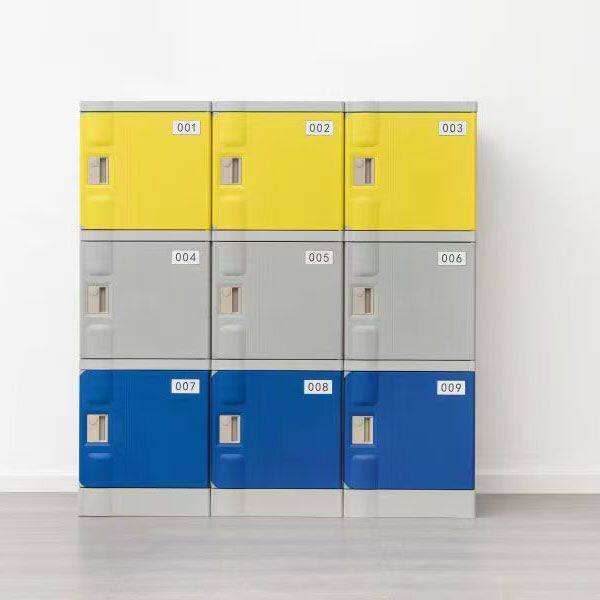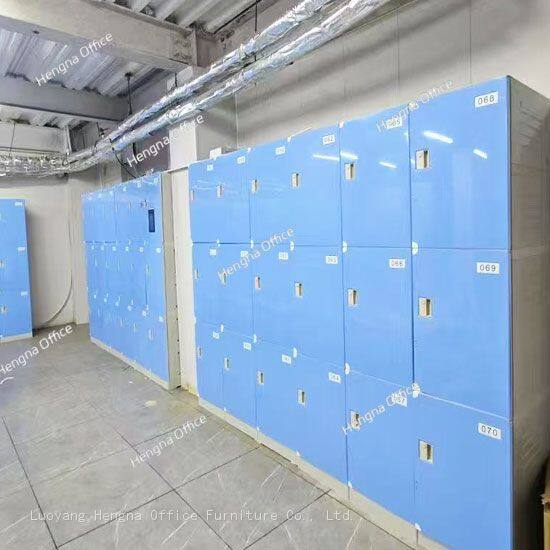Home > Blog > The Ultimate Guide to Factory Staff Lockers: Top 7 Reasons ABS Plastic Outperforms Metal in Workplac
-
 Sarah
Hi there! Welcome to my shop. Let me know if you have any questions.
Sarah
Hi there! Welcome to my shop. Let me know if you have any questions.
Your message has exceeded the limit.

The Ultimate Guide to Factory Staff Lockers: Top 7 Reasons ABS Plastic Outperforms Metal in Workplac
2025-10-21 18:07:28
In the complex ecosystem of factory operations, staff lockers represent far more than simple storage compartments—they’re critical components of workplace infrastructure that impact security, efficiency, and employee satisfaction. For decades, metal lockers dominated industrial facilities, but technological advancements in materials science have introduced a superior alternative: ABS plastic staff lockers. This comprehensive guide examines the seven compelling reasons why ABS plastic has emerged as the preferred choice for modern factory storage solutions, outperforming traditional metal lockers across multiple critical dimensions.
Reason 1: Unmatched Durability in Harsh Environments
Superior Material Properties
ABS plastic possesses inherent material properties that make it exceptionally well-suited for industrial environments:
Impact Resistance: ABS plastic can withstand significant force without denting, cracking, or breaking. In factory settings where equipment movement and accidental impacts are common, this resilience proves invaluable. Metal lockers, by contrast, readily dent and deform, compromising both appearance and function.
Structural Consistency: Unlike metal lockers that may develop weak points at welds and joints over time, ABS lockers maintain consistent structural integrity throughout their service life. The uniform material composition eliminates potential failure points common in assembled metal lockers.
Environmental Adaptability: ABS plastic performs reliably across temperature extremes (-40°C to 80°C) and humidity levels, making it suitable for diverse industrial environments from climate-controlled facilities to unconditioned manufacturing areas.

Real-World Performance Data
Industrial facilities that have transitioned to ABS lockers report dramatic improvements in durability:
Reduced Damage Incidents: One automotive manufacturing facility reported a 78% reduction in locker damage complaints after replacing metal lockers with ABS alternatives.
Extended Service Life: Facilities typically report 15-20 years of service from ABS lockers compared to 5-10 years for metal equivalents in similar industrial environments.
Consistent Performance: ABS lockers maintain their appearance and function throughout their lifespan, unlike metal lockers that gradually deteriorate through corrosion and impact damage.
Reason 2: Significant Long-Term Cost Savings
Total Cost of Ownership Analysis
While the initial purchase price may be comparable, the total cost of ownership reveals ABS lockers as the more economical choice:
Maintenance Cost Reduction: ABS lockers require approximately 85% less maintenance than metal alternatives over their lifespan. The absence of rust treatment, dent repair, and repainting requirements translates to substantial savings.
Extended Replacement Cycles: The durability of ABS lockers means facilities can replace them less frequently, reducing both material costs and installation expenses.
Operational Efficiency: With fewer lockers out of service for repairs, facilities maintain consistent storage capacity without the disruptions associated with frequent maintenance and replacement.
Reason 3: Enhanced Safety Features
Injury Prevention Design
ABS plastic lockers incorporate several safety advantages that protect factory workers:
Smooth, Rounded Edges: Unlike metal lockers that may develop sharp edges when damaged, ABS lockers maintain smooth contours even after impact, reducing the risk of cuts and scrapes.
No Sharp Protrusions: The uniform construction of ABS lockers eliminates the screws, bolts, and sharp edges common in metal locker assembly that can cause injuries.
Stable Construction: ABS lockers maintain consistent weight distribution and structural integrity, reducing tipping risks that can increase as metal lockers deteriorate.
Chemical and Electrical Safety
Industrial environments present specific safety challenges that ABS lockers address effectively:
Non-Conductive Material: ABS plastic eliminates electrical conductivity hazards, an important consideration in facilities where electrical safety is paramount.
Chemical Resistance: ABS plastic resists degradation from common industrial chemicals, preventing the release of harmful substances that could occur with deteriorating metal lockers.
Reason 4: Superior Hygiene and Cleanliness
Bacterial Resistance and Cleanability
In modern industrial settings, hygiene has become an increasingly important consideration:
Non-Porous Surface: The smooth surface of ABS plastic resists bacterial growth and allows for thorough sanitization with standard cleaning agents. Metal lockers, with their seams, joints, and potential corrosion points, provide harborage for bacteria.
Stain Resistance: ABS plastic resists staining from oils, grease, and other common industrial substances, maintaining a clean appearance with minimal effort.
No Rust Contamination: Unlike metal lockers that can contaminate stored items with rust particles, ABS lockers maintain a clean, rust-free environment.
Pandemic-Responsive Design
The COVID-19 pandemic has heightened awareness of surface hygiene in workplace settings:
Effective Sanitization: ABS lockers can be effectively sanitized with hospital-grade disinfectants without material degradation, supporting enhanced hygiene protocols.
Reduced Contamination Risk: The non-porous surface minimizes the risk of pathogen transmission compared to the more complex surfaces of metal lockers.
Reason 5: Customization and Flexibility

Design Versatility
ABS plastic offers unprecedented design flexibility for industrial applications:
Color Coding: Different colors can designate departments, shifts, or security levels, improving organization and security. Metal lockers typically offer limited color options and require painting for customization.
Size Configurations: ABS lockers can be manufactured in various sizes and configurations to accommodate space constraints and specific storage needs.
Integrated Features: ABS manufacturing allows for integrated features like built-in hooks, shelves, and ventilation systems that would require additional components in metal lockers.
Adaptability to Changing Needs
Industrial facilities evolve over time, and storage solutions must adapt:
Modular Design: Many ABS locker systems offer modular components that can be reconfigured as facility needs change.
Easy Modification: ABS lockers can be more easily modified or expanded than metal alternatives, providing greater long-term flexibility.
Reason 6: Environmental Sustainability
Lifecycle Environmental Benefits
Modern industrial facilities increasingly prioritize sustainability in their equipment choices:
Manufacturing Efficiency: ABS locker production typically consumes less energy than metal manufacturing, resulting in a lower carbon footprint.
Recyclability: At end-of-life, ABS lockers can be recycled and repurposed, supporting circular economy principles. Metal lockers, while also recyclable, often require more energy-intensive recycling processes.
Reduced Resource Consumption: The extended lifespan of ABS lockers means fewer resources consumed over time for replacements and maintenance.
Compliance with Environmental Regulations
ABS lockers help facilities meet increasingly stringent environmental requirements:
No Harmful Coatings: Unlike metal lockers that may require protective coatings containing VOCs, ABS lockers are manufactured without these potentially harmful substances.
Reduced Chemical Usage: The absence of rust treatment requirements eliminates the need for chemical rust inhibitors that can pose environmental concerns.
Reason 7: Enhanced User Experience
Employee Satisfaction
The quality of staff lockers impacts employee perception and satisfaction:
Modern Appearance: ABS lockers maintain a clean, modern appearance throughout their lifespan, contributing to a positive workplace environment. Metal lockers often appear dated as they age and deteriorate.
Consistent Performance: Employees appreciate lockers that function reliably without jamming, sticking, or developing other issues common with aging metal lockers.
Personalization Options: ABS lockers offer more options for personalization while maintaining structural integrity, allowing employees to customize their storage space within appropriate limits.
Operational Convenience
Beyond individual user experience, ABS lockers offer operational advantages:
Quiet Operation: ABS plastic absorbs sound rather than amplifying it like metal lockers, reducing noise pollution in busy factory environments.
Consistent Function: Doors and locking mechanisms operate consistently throughout the locker’s lifespan, unlike metal lockers that may develop alignment issues over time.
Implementation Best Practices
Assessment and Planning
Successful implementation of ABS lockers requires careful planning:
Needs Assessment: Evaluate current storage requirements, space constraints, and future growth projections.
Budget Consideration: Consider both initial investment and long-term savings when planning the transition.
Stakeholder Engagement: Involve maintenance staff, safety personnel, and employee representatives in the planning process.
Phased Implementation
For large facilities, a phased approach minimizes disruption:
Pilot Installation: Test ABS lockers in one department or area to evaluate performance and gather feedback.
Feedback Collection: Solicit input from users and maintenance staff to refine the implementation plan.
Full Rollout: Implement across the facility based on lessons learned from the pilot phase.
Performance Monitoring: Continuously evaluate performance and address any issues promptly.
The Future of Industrial Storage
The seven reasons outlined in this guide demonstrate why ABS plastic staff lockers have become the preferred choice for modern factory storage solutions. From unmatched durability and significant cost savings to enhanced safety, superior hygiene, customization flexibility, environmental sustainability, and improved user experience, ABS lockers outperform metal alternatives across every critical dimension.
As industrial facilities continue to evolve and face increasing pressure to optimize operations while ensuring workplace safety and sustainability, the adoption of ABS staff lockers represents a forward-thinking decision that delivers comprehensive benefits. The transition from metal to ABS lockers is not merely a material change—it’s an investment in a more efficient, safer, and more sustainable industrial workplace.
For facility managers seeking to optimize their storage infrastructure while maximizing long-term value, ABS plastic staff lockers offer the ideal combination of performance, economy, and versatility. The evidence is clear: ABS plastic has redefined industrial storage solutions, setting a new standard that metal alternatives simply cannot match.
Tags: Guide to Factory Staff Lockers, Factory Staff Lockers, ABS Plastic Outperforms Metal in Workplac

